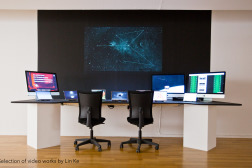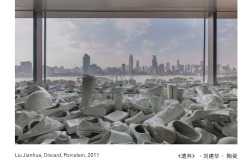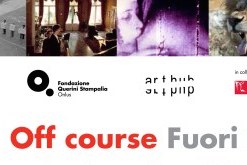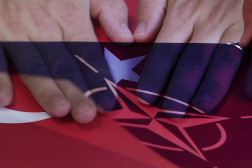
Arthub Supports the Arrow Factory in Beijing
Arthub is thrilled to have found a space in Beijing that is genuinely seeking to present art in a non-commercial environment and that is part of a lively neighborhood in the heart of the city. The group of artists and curators (Pauline Yao, Wei Weng, Wang Wei and Rania Ho) are there to make a difference and Arthub is happy to support them with a small contribution for the year 2009.
About Arrow Factory
Arrow Factory is an independently run alternative storefront space that seeks to advance artistic collaboration, exploration and experimentation across different cultural contexts and viewing public spaces. Located in a small hutong in Beijing’s city center, Arrow Factory reclaims existing commercial space to present artworks that stimulate dialogue between art and contemporary urban space. Aimed at reaching a diverse public made up of local residents, as well as local and international art audiences, our modestly sized space (approximately 10 square meters or 100 square feet) is intended to create new avenues for artistic production in China and further aesthetic relationships between contemporary art and everyday life. Arrow Factory will invite artists living inside and outside of China to create site-specific installations and projects that will be available for view in its storefront location 7 days a week.
Small is the New Big–The Arrow Factory
By Pauline J. Yao
Over the last few years the development of contemporary art in China has been both sweeping and incremental. Swift leaps in the commercial sector and halting acceptance on the official side has left an infrastructure that is unstable and highly porous, if existent at all. A brief scan of today’s art spaces and organizations reflects a contemporary Chinese art world that sits heavy with ambition to establish institutional, professional and educational systems that will put it on par with its global neighbors, and yet is largely inattentive to the long-term sustainability of these structures. Moreover, the recent fast-track commercial success and dominating presence of the market has not only jeopardized these systems but has also dissuaded more adventurous modes of artistic experimentation and discourse. If 798 or Caochangdi have become synonymous for recent advances within contemporary art and cultural industry in China, they are also symptomatic of deeper ills in terms of excessive reliance on commercialism, elitism, spectacle-driven events, and over-sized gallery spaces that have skewed artistic production towards quantity over quality.
Designating special areas of the city as ‘art districts’ is one of the more visible ways that the Beijing city government has manifested its support for contemporary art. But exiled in increasingly remote corners of the city, these designated art zones pose important questions about accessibility—they represent not only a physical removal from the urban fabric of the city, but a psychological barrier as well—and consumption, given that the work shown there is made by and for individuals that frequent these contexts alone. The motivation behind these districts is geared not towards engaging and interacting with the surrounding area or building ties to local communities beyond the art world itself, but rather cutting oneself off behind fortress–like gates that make patently visible the lines of demarcation between the art-indoctrinated and average working inhabitants. The contemporary art “bubble” is thus more than market phenomenon, it also extends geographically to define these enclaves which seem to put art and artists in a cordoned off area, severing an artwork’s ties to the very social and political conditions it is alleged to represent.
Enter the Arrow Factory, located inside Beijing’s Second Ring road, far away from any art districts and high-powered art museums or developments. Situated in a hutong alley near the center of the city, Arrow Factory presents a model of an art space whose approach to exhibition making and display is uniquely defined by its physical location and immediate social setting. Our modestly sized space (15 sqm) provides an alternative scale to the ever-expanding commercial gallery spaces and art districts, but also serves a practical purpose since we are entirely self-organized and self-funded out of our own pockets. Under the current climate in Beijing, where the experience of encountering contemporary art has been largely confined to purpose-built art districts, Arrow Factory aims to present art in a context that reaches beyond the sanctified white-box setting of museums and galleries, seeking to bring artistic participation, exploration and experimentation up against the social and political realities of everyday life.
The Arrow Factory has several features that set it apart from the usual contemporary art spaces in Beijing. We are not only small in size but we operate as a storefront, with projects that are designed to be viewed from the street only while glass doors to the space remain locked. Our rental of the space (a former vegetable stand) comes with a temporary commercial business license, but in reality we do not sell anything.
There are no opening parties at the Arrow Factory (unless the artist takes it upon him/herself to organize it), nor is there much in the way of signage, advertising or promotion. Instead we offer restrained interventions into the everyday context of the hutong in the form of installations and video works that maintain continual dialogue with the local surroundings and are available for viewing nearly 24 hours a day to anyone passing by. For us, meaning making is an activity that occurs through interacting with the pre-existing social field of the local environment, and adopting a strategy whereby the social frame does not so much ‘surround’ as much as it becomes part of the work. By encouraging modes of art making that are specific and contingent, rooted in time and in place, we hope to give fuller attention to art that embody forms of lived experience and meaningful responses to the diverse economic, political and social conditions of our given locality.
In any given city, there are gallery districts and art enclaves, but there are also notable exceptions too. The act of staking out new territory, as we have done, is rooted in the idea that art does something, that it has functionality and purpose and can enact some form of change either through critique, exposing truths or merely through the nature of its existence in that site in the first place. By situating ourselves in Jianchang Hutong (a seemingly arbitrary locale) we aim to accentuate the relationships between people and space that radiate outwards from the levels of the individual, the neighborhood, the urban, the region, to finally, the global. This is reflected in our audience, which is made up mostly of local residents who either live in the hutong or frequent the area on a daily basis, and the occasional global traveler. Unlike our counterparts in 798 or Caochangdi, which tend draw a motivated and interested audience already familiar with art, our activities are passively met with puzzled looks and quirky comments from the neighboring residents and passersby who have been known to remark, “you’d be better off selling vegetables.”
Arrow Factory was founded in April 2008 by three artists–Rania Ho, Wang Wei, Wei Weng; and one curator—Pauline J. Yao, all based in Beijing. Aside from the occasional cash donations by friends and participating artists, we are completely self-funded and operated. We use ‘non-profit’ and ‘alternative’ and ‘independent’ to describe what we do, though admittedly these terms have grown increasingly vague. We consider ourselves to be non-profit not only because of the types of programming we present and artists we support, but because of our stated goal to stay free of the usual commercial entanglements. Thus we do not handle sales of artworks nor do we collect any percentages or commissions. Our thinking behind starting Arrow Factory might be seen to fit with the classic definition of an “alternative art space” as pioneered by various artist-run spaces in America during the 1970’s and ’80’s, whose mission was to take up a firm position against excess commodification and prevalence of so-called ‘institutional’ ideologies. But to see things only in these oppositional terms neglects our own complicit role in the structure of the art world itself, as Andrea Fraser puts it, “[it’s] not a question of being against the institution, we are the institution. It’s a question of what kind of institution we are, what kind of values we institutionalize, what forms of practice we reward, and what kinds of rewards we aspire to.”
The four projects we have organized to date each in some way represent the types practices we value and the working strategies that we reward—approaches to exhibition making that are inventive and interactions with locality that are participatory and collaborative. Slice (April 30th to July 12th, 2008) is a collaborative work by Arrow Factory co-founders Rania Ho and Wei Weng. The two main works—a life-size ping-pong table handcrafted out of cheap cardboard materials by Rania Ho, and a site-specific wall painting by Wei Weng allude to acts of cutting, slicing and carving and elicit notions of movement and perspectival shifts in space. Though the works yielded valuable associations to craft, the handmade and the ensuing Olympic games, passersby were likely most enthralled by Ho’s addition of a constantly levitating ping-pong ball atop the makeshift ping-pong table.
New York based artist Patty Chang’s project entitled Touch Would (July 29th to September 29th, 2008) represents Arrow Factory’s ongoing interest in highlighting the artistic process and issues of production. Shot in Beijing and co-produced by the Arrow Factory, Touch Would is a two-channel video work that centers on the concept of translation and performance. It takes as its departure point events that concern the cultural critic Walter Benjamin and Asian American film starlet Anna May Wong, but reimagined and reinterpreted in a contemporary context. The project forms a lens through which Chang explores notions of public/private space, staged performance, and linguistic mishap. Presented in the hutong environment of Arrow Factory, the piece gained instant popularity with the local audience who stopped by often to watch the video of the teenage knife thrower show off his talents.
Vive la Différence (November 7th, 2008 to January 7th, 2009) is an installation created by artist Ni Haifeng that directly reflects an interest towards collaboration and involvement with the local economies of the hutong. Using shreds of fabric that have been discarded after commercial factory production, the artist invited two different design teams to produce a pair of unique “high-end” fashion garments; these garments were then installed in Arrow Factory in the form of a luxury shop window display that clashed with the modest surroundings of the hutong. Ni purposefully chose collaborators with dramatically different economic backgrounds—one is an international design team based in Beijing and the other is the local tailor shop in the hutong, to expose the visual dissonance and economic difference between the extremely lavish and the humble aesthetic of the local.
Our most recent project is a video installation by Beijing-based Wang Gongxin entitled It’s Not About the Neighbors (January 22nd to April 2nd, 2009). The work also engages with the immediate context of Arrow Factory’s hutong alley location but enlists a more visually minded approach. During the day, It’s Not About the Neighbors is a sculptural installation that offers an uncanny imitation of the neighboring pancake shop’s façade, while at nightfall, the work comes to life through a backlit video projection that simulates the neighboring shop workers making and selling their bread and noodles. The overriding visual connection between these two adjacent spaces is undermined by their different functions: one is an operating business that depends on local residents and neighbors for its income; the other is independent and non-functional, relying instead upon the visual economies of the hutong itself. Offering an indexical relationship to its own location, It’s Not About the Neighbors is also aimed at uncovering new questions about presenting contemporary art in public contexts.
From April to May, Arrow Factory will work with artist Kan Xuan to launch the first in a series of projects we are tentatively calling “Incubator Projects.” The idea is to use the space of Arrow Factory to give an artist the opportunity to test out different ideas or concepts, showing only semi-finished work or works-in-process that are continually modified over a fixed period of time. Instead of exhibiting a finished work at the beginning, the work will only reach completion at the end, representing an inverse model of a conventional exhibition format. It is hoped that artists can benefit by diverting attention away from a finished concept towards one that is constantly evolving within the space and that gives the viewing public a deeper look into the artistic process.
The interests of Arrow Factory, in the end, are not at odds with the goals of other art spaces residing in larger art districts, but rather seek to work in tandem with them by providing alternative ways of seeing and producing art and by encouraging modes of making that are contingent and yet committed to a spirit of experimentation. Given the ubiquitous presence of ‘white-box’ spaces, which insist on prescribed encounters with contemporary art, we find that Arrow Factory can offer a much needed platform for artists to engage directly with the social relations of a specific site and ultimately, to remind us of art’s unbreakable temporal relation to conditions of the present.




